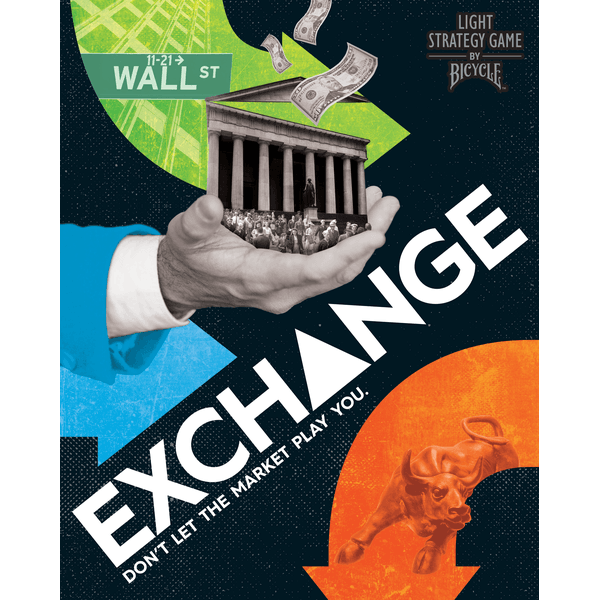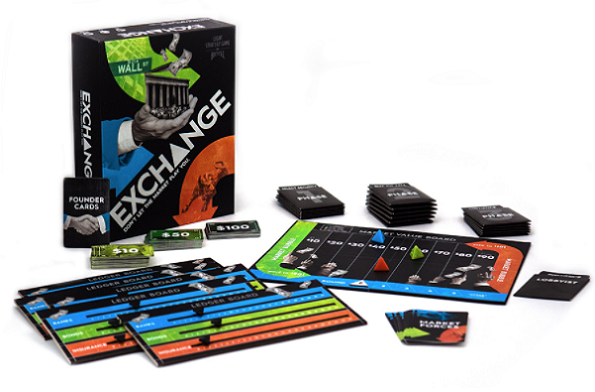Manipulate the Market and Your Opponents in Stock Market Game Exchange

Predict how the market will fluctuate, keep an eye on your opponents, predict their choices, and outwit them with your own.
From Bicycle, Exchange has players secretly selecting which assets they want to buy or sell each round, while also manipulating the values of the assets.
Gameplay
Each player takes a ledger board, on which they will track which assets they have and how many of each. There are three types of assets: banks, bonds, and insurance. Each player starts the game by being dealt a founder card, which gives them certain assets to start the game with as well as a starting amount of cash. In the center of the table is placed the market value board, which tracks how much each asset is worth. Asset values go up and down in increments of $10 and can have a value between $10-$90 (or $20-$80 in a three to four player game).
The game is played over five rounds and each round has several phases. During phase one, each player secretly selects one of three asset types and then simultaneously reveals their choices. This is the asset you will be buying or selling this round. During the second phase, you secretly select whether you are buying or selling and how many (you can choose one to nine). However, you do not yet reveal your decision. During phase three, everyone simultaneously chooses one asset type to affect its value, either increasing its value by $10 or lowering it by $10. This information is then revealed. A market force card is drawn next. This will also affect the values of the assets. Players adjust the values on the board. If any asset would exceed the maximum or minimum possible value, the market bursts and that asset’s value wraps around to the other side of the value board. So, for example, if an asset is at a value of $90 and a player increases its value by $10, it will now move to the bottom of the board and be worth only $10.
After the value changes of all the assets have been resolved, players reveal how many stocks they are buying or selling, taking cash from the bank for any stocks they sold and spending money for any stocks they bought.
The player with the most cash (not counting the value of their current stocks) during rounds two through five, is the lobbyist and gets to influence the market a second time during phase three. Also, a player may spend $50 in order to look at the top card of the market forces deck, so that they know what is coming.
After round five, players get one final chance to affect the value of the assets, and then everyone counts up their cash and how much all the assets they own are worth. The player with the highest net worth wins the game.

Review
There is a really nice simplicity to Exchange. All you are doing is reading the room and studying the boards. What are assets worth and who has what? There are no auctions or complicated card plays. It’s purely about buying low and choosing the perfect moment to sell high, while trying to sabotage your opponent’s efforts to do the same.
The market forces cards bring an extra level of uncertainty to each round, while the ability to spend money to see what they’re going to do is a really clever mechanic. That card may or may not help you, but that knowledge can also be extremely useful. The ability to spend in order to take out this luck of the draw is a neat idea that would be interesting to see in other games.
Exchange has lots of opportunities to try to bluff your opponents while also trying to figure out what they’re up to. Maybe you want to sell insurance assets and they’re currently worth $70. Do you risk increasing their value? Or do you think another player might try to burst the market. Should you in fact try lowering the value to combat this attempt? Since each player can see which asset you are buying or selling, but not exactly what you are doing with that asset, when choosing how to influence the market, there are lots of opportunities to mess with each other’s heads.
The component quality of the game is excellent. The ledger boards in particular have great sliders for tracking your assets. Setting up the game is also extremely fast and easy to do, and it’s a quick game to teach, so you can easily be playing in about five minutes. However, we did find the rulebook a little difficult to understand. It could be a little clearer on when cards are revealed and the order in which actions occur.
Exchange’s theme may initially lose some players' interests, but once it gets going you really appreciate how accessible and interactive it is. With all choices made simultaneously, there’s very little downtime. Even if the idea of a stock market game doesn’t immediately leap out at you, give it a chance. This is a fun one that can appeal to a wide audience.
Pros: Player interaction, minimal downtime, ease of setup, component quality
Cons: Theme may not interest everyone, rulebook could be clearer
Disclosure: we received a complimentary review copy of this game.







